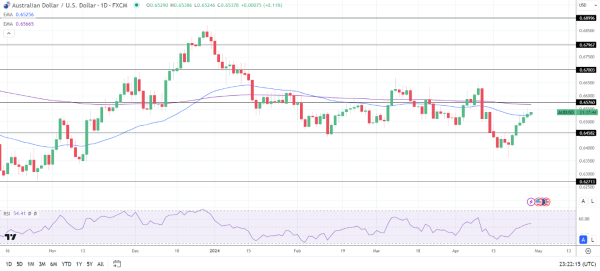AUD to USD Forecast: Retail Sales Data to Steer RBA Trajectory Sentiment
Australian Inflation and the RBA Interest Rate Trajectory
On Monday (April 29), market risk sentiment will likely set the tone for the session. However, investor sentiment toward the RBA interest rate trajectory will impact buyer demand for the AUD/USD.
The Aussie annual inflation rate eased from 4.1% to 3.6% in Q1 2024 versus a 3.4% forecast. Moreover, producer prices increased 4.3% year-on-year in Q1 2024 after rising 4.1% in Q4 2023. Economists expected producer prices to advance by 2.6% year-on-year.
Producers raise prices in an improving demand environment, passing costs onto consumers. The Q1 2024 figures signal upward consumer price trends. A more hawkish RBA rate path could raise borrowing costs and reduce disposable income. Downward trends in disposable income could affect consumer spending and dampen demand-driven inflation.
After better-than-expected private sector PMIs for April, Aussie retail sales figures could further influence speculation about an RBA rate hike. Preliminary retail sales numbers will be in focus on Tuesday (April 30). Economists forecast retail sales to increase by 0.2% in March after rising by 0.3% in February.
Upward trends in consumer spending could fuel demand-driven inflationary pressures.
There are no economic indicators from Australia to consider today.
US Economic Calendar: The Dallas Fed Manufacturing Index
Later in the session, the Dallas Fed Manufacturing Index will draw investor interest. The figures are unlikely to influence the Fed rate path, with the manufacturing sector accounting for less than 30% of the US economy. Nevertheless, the numbers could affect investor expectations of the US avoiding an economic recession.
Economists forecast the Dallas Fed Manufacturing Index to increase from -14.4 to -11.0 in April.
Despite fading bets on multiple 2024 Fed rate cuts, investors remain hopeful of a September rate cut. According to the CME FedWatch Tool, the chances of a 25-basis point September Fed rate cut stood at 45.9% this morning.
Short-Term AUD/USD Forecast
Near-term AUD/USD trends will hinge on Australian retail sales figures, US labor market data, and the US Federal Reserve. Better-than-expected Australian retail sales could raise investor bets on an RBA rate hike. A more hawkish RBA rate path could tilt monetary policy divergence toward the Aussie dollar.
AUD/USD Price Action
Daily Chart
The AUD/USD sat above the 50-day EMA while remaining below the 200-day EMA, sending bullish near-term but bearish longer-term price signals.
An Aussie dollar break above the 200-day EMA and the $0.65760 resistance level would support a return to the $0.66 handle.
RBA rate hike speculation, market risk sentiment, and the US economic calendar need consideration.
Conversely, an AUD/USD drop below the 50-day EMA would bring the $0.64582 support level into play.
Given a 14-period Daily RSI reading of 54.41, the AUD/USD may move to the $0.66 handle before entering overbought territory.
